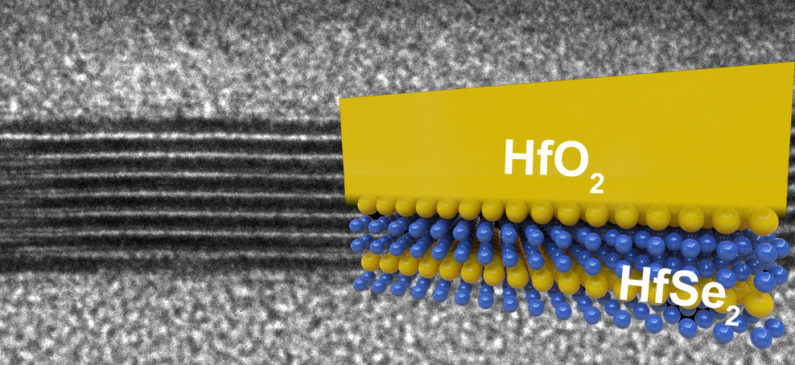New ultrathin semiconductor materials exceed some of silicon's "˜secret' powers

Cross-section of an experimental chip. In this greatly enlarged cross-section of an experimental chip, the bands of black and white reveal alternating layers of hafnium diselenide "“ an ultrathin semiconductor material "“ and the hafnium dioxide insulator. The cross-section matches an overlaid color schematic on the right. (Image credit: Michal Mleczko)
Chip makers appreciate what most consumers never knew: silicon's virtues include the fact that it "rusts" in a way that insulates its tiny circuitry. Two new ultrathin materials share that trait and outdo silicon in other ways that make them promising materials for electronics of the future.
The next generation of feature-filled and energy-efficient electronics will require computer chips just a few atoms thick. For all its positive attributes, trusty silicon can't take us to these ultrathin extremes.
In this greatly enlarged cross-section of an experimental chip, the bands of black and white reveal alternating layers of hafnium diselenide "“ an ultrathin semiconductor material "“ and the hafnium dioxide insulator. The cross-section matches an overlaid color schematic on the right. (Image credit: Michal Mleczko)
Now, electrical engineers at Stanford have identified two semiconductors "“ hafnium diselenide and zirconium diselenide "“ that share or even exceed some of silicon's desirable traits, starting with the fact that all three materials can "rust.
"It's a bit like rust, but a very desirable rust," said Eric Pop, an associate professor of electrical engineering, who co-authored with post-doctoral scholar Michal Mleczko a paper that appears in the journal Science Advances.
The new materials can also be shrunk to functional circuits just three atoms thick and they require less energy than silicon circuits. Although still experimental, the researchers said the materials could be a step toward the kinds of thinner, more energy-efficient chips demanded by devices of the future.
Silicon's strengths
Silicon has several qualities that have led it to become the bedrock of electronics, Pop explained. One is that it is blessed with a very good "native" insulator, silicon dioxide or, in plain English, silicon rust. Exposing silicon to oxygen during manufacturing gives chip-makers an easy way to isolate their circuitry. Other semiconductors do not "rust" into good insulators when exposed to oxygen, so they must be layered with additional insulators, a step that introduces engineering challenges. Both of the diselenides the Stanford group tested formed this elusive, yet high-quality insulating rust layer when exposed to oxygen.
Not only do both ultrathin semiconductors rust, they do so in a way that is even more desirable than silicon. They form what are called "high-K" insulators, which enable lower power operation than is possible with silicon and its silicon oxide insulator.
As the Stanford researchers started shrinking the diselenides to atomic thinness, they realized that these ultrathin semiconductors share another of silicon's secret advantages: the energy needed to switch transistors on "“ a critical step in computing, called the band gap "“ is in a just-right range. Too low and the circuits leak and become unreliable. Too high and the chip takes too much energy to operate and becomes inefficient. Both materials were in the same optimal range as silicon.
All this and the diselenides can also be fashioned into circuits just three atoms thick, or about two-thirds of a nanometer, something silicon cannot do.
"Engineers have been unable to make silicon transistors thinner than about five nanometers, before the material properties begin to change in undesirable ways," Pop said.
The combination of thinner circuits and desirable high-K insulation means that these ultrathin semiconductors could be made into transistors 10 times smaller than anything possible with silicon today.
"Silicon won't go away. But for consumers this could mean much longer battery life and much more complex functionality if these semiconductors can be integrated with silicon," Pop said.
There is much work ahead. First, Mleczko and Pop must refine the electrical contacts between transistors on their ultrathin diselenide circuits. "These connections have always proved a challenge for any new semiconductor, and the difficulty becomes greater as we shrink circuits to the atomic scale," Mleczko said.
They are also working to better control the oxidized insulators to ensure they remain as thin and stable as possible. Last, but not least, only when these things are in order will they begin to integrate with other materials and then to scale up to working wafers, complex circuits and, eventually, complete systems.
"There's more research to do, but a new path to thinner, smaller circuits "“ and more energy-efficient electronics "“ is within reach," Pop said.

































